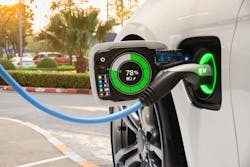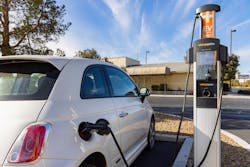How to Support Safe EV Charging
The global energy transition is being driven by the progressive replacement of carbon-based fuels with renewables and the direct/indirect electrification of more applications, including transportation. It’s important to understand that electric vehicle charging infrastructure (EVCI) involves much more than just adding the physical charging device. There are wide-ranging demands on a building’s electrical infrastructure to handle the incremental energy load of the chargers. This increased energy consumption can impact incoming electric utility service and power distribution system design as well as necessitate distributed energy resources like solar and battery storage to offset electricity demand and time-of-use rates.
Electric vehicle (EV) adoption is obviously on the rise in the United States. In August, President Joe Biden signed an executive order setting a target of 50% of passenger vehicles sold by 2030 to be electric. Additionally, the governor of New York recently set goals for all passenger cars and light-duty trucks sold in the state to be zero-emission vehicles by 2035; California has similar requirements for light-duty autonomous vehicles to emit zero emissions starting in 2030.
To accommodate this growth, many states are challenging building owners to develop “EV-ready” power distribution systems that have electrical infrastructure capacity, dedicated branch circuits, and other equipment to distribute power to EV parking spots and support the future installation of charging stations.
Today, more than ever, the electrical infrastructure supporting commercial buildings must be able to adapt to change. In our opinion, that means designing buildings to safely support the EV charging needs of the future. In this article, we’ll summarize various considerations for safe EVCI, including:
- Code compliance for EV charging systems.
- Strategies to increase electrical capacity in buildings.
- How to safely manage growing electrical demand.
Codes and standards for safe EVCI system installation
When it comes to National Electrical Code (NEC) requirements for EVCI installation, there are several rules that affect EV charging systems. Some of these, per the 2020 edition of the NEC, include the following:
- Chapters 1 to 4 apply generally to all electrical installations. These chapters include requirements for load calculations that impact branch circuit, feeder and service sizes (or even a separate service), metering for fee-for-charging applications, and more.
- Section 625.40 mandates each outlet installed for the purpose of supplying EVCI shall be supplied by an individual branch circuit.
- Section 625.48 requires overcurrent protection with a rating sufficient for the receptacle it protects. The overcurrent protection device must also be rated for the maximum available fault current at the receptacle and included in the interactive equipment evaluation.
- Section 625.41 states overcurrent protection for feeders and branch circuits supplying EVCI shall be sized for continuous duty with a current rating of not less than 125% of the maximum load of the equipment.
- Section 625.5 requires third-party testing and relevant listing of all electrical materials, devices, fittings, and associated equipment.
In addition to the NEC, there are relevant product safety certifications specific to AC charging (UL 25942), DC charging (UL 2202 and UL 2231), and bidirectional charging (UL 9741) that should be adhered to.
Charging options
Both AC and DC charging options have their place, each of which comes with business and installation considerations.
AC charging is typically used in situations where a vehicle will spend the most time parked (e.g., work, school, shopping, entertainment, or hotels). Level 1 charging can also be used in locations where vehicles are parked overnight but can take up to 12 hours to fully charge; Level 2 charging typically takes approximately four hours to charge.
DC-type charging is preferred in some applications and for specific needs, depending on vehicle routes and dwelling time. This type of charging involves more power and can deliver a required charge in as little as 30 minutes.
It’s expected that AC charging will represent the largest global public installs through 2025, and DC charging will provide critical network support on long travel routes like interstate highways as well as support for fleet operations and charging at popular destinations. Further, EV charging systems can be optimized with charge management software, battery energy storage, and the integration of renewables (like solar) to meet cost, resilience, and sustainability goals.
Strategies to increase electrical capacity
When upgrading or designing building systems, planning for future EVCI capacity needs to avoid significant changes and costs later is important. In other words, you need to future-proof and provide the electrical architecture for what’s to come. How many chargers will be required? How much additional power (kVA) do you need to accommodate for growth? It is critical that incoming utility electrical service and power distribution feeders are sized appropriately to be able to power EV charging safely and reliably.
For example, EVs are expected to make up 10% of the new car market in America by 2025 — meaning a typical local distribution center could reasonably expect to convert 10% or more of its parking capacity to bays with chargers. Most of these chargers (90%) could be Level 2 chargers for employees, but several would need to be DC fast chargers for local delivery trucks, which need much more power. Even if only half of the chargers at the facility are used at any one time, the site’s power demand can easily increase by a megawatt, effectively doubling the power requirements.
Building owners should consider this vastly increased power requirement before adding EVCI because sufficient electrical capacity may not be available. Current versions of DC rapid chargers typically have a power demand of 20kW to 350kW. However, more powerful chargers are becoming available. Careful planning and system design are essential to maximizing the return on investment for costly site upgrades associated with pulling more power from the electric grid.
Optimizing EVCI with load management technology will enable more installed chargers that deliver the optimal amount of power chargers need. When available capacity is reached, load management software limits energy consumption and reduces the available power. This integral approach to load management enables load shedding and avoids exceeding the incoming service capacity. However, if current electrical capacity simply cannot meet expected demand, electrical capacity must be increased at the electric utility service point.
An alternative to increasing service entrance upgrades is to incorporate onsite renewables and energy storage. This strategy enables owners and building managers to avoid expensive electrical capacity additions while supporting a more sustainable, low-carbon future.
Safe, flexible EVCI will power the 21st centuryNow and in the future, electrical infrastructure needs to do much more than just receive power from the grid for distribution to building loads and equipment. With the significant growth of EVs on the horizon, it is important to start thinking about what steps are required to build safe EVCI for commercial buildings.
There is an enormous opportunity to manage power far more effectively, taking advantage of a new power paradigm that is decentralized, electrified, and decarbonized. If completed with safety and reliability in mind, the critical task of adding EVCI can be accomplished without unnecessary costs or complications down the road. That being said, there is no doubt that EVCI design and NEC requirements will continue to evolve, so energy infrastructure can work in new ways to ensure the power is always on and optimized for efficiency and safety.
Lawrence T. Conner is a senior application specialist in renewable energy at Eaton. Jaska Tarkka is a solar application engineer at Eaton. They can be reached at [email protected].
About the Author
Lawrence Conner
Larence is a senior application specialist, renewable energy with Eaton.
Jaska Tarkka
Jaska is a solar application engineer at Eaton.

